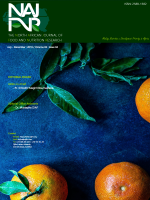Main Article Content
Modeling of nitrate leaching kinetics during spinach leaf midribs blanching
Abstract
Background: Although nitrates, are sometimes favorable to health, they can however convert to nitrosamines inside the body thanks to the acidic medium of gastrointestinal tract. So, the investigation of the nitrate content in food products becomes an imperative since it allows consumers to choose their food deliberately.
Aims: The leaching kinetics of nitrates during water blanching of spinach leaf midribs (SLM) was investigated at different conditions of time and temperature.
Material and Methods: The nitrate leaching kinetics, during the water blanching of SLM samples, was studied at 60, 70 and 80 °C; for 3 and 15 minutes. Presently, six models, namely Henderson and Pabis, logarithmic, zero order, Lewis, Page, Wang, and Singh were tested to analyze experimental data. Moreover, to elucidate the effect of the temperature on the nitrate diffusion rate, the equation of Arrhenius was applied. Results:
Results: showed that after 15 min of blanching, the removal rate (RR) of nitrates was of: 23.851 ± 3.477c, 64.809± 0.474b and 75.949 ± 5.366a % at 60, 70 and 80 °C, respectively; with a significant difference between values at (p ≤ 0.05). Furthermore, among the six tested models, the logarithmic model seemed to be the most appropriate (R2 > 0.993) to describe the diffusion kinetics of nitrates from food matrix into the blanching water, whatever the processing temperature. Finally, the activation energy (35.76 kJ. Mol-1), characterizing the nitrate leaching, was assessed based on the rate constant appearing in the most appropriate model.
Conclusions: Blanching in water constitutes an effective tool for controlling the nitrate content in vegetables, by varying the time and temperature of treatment.







